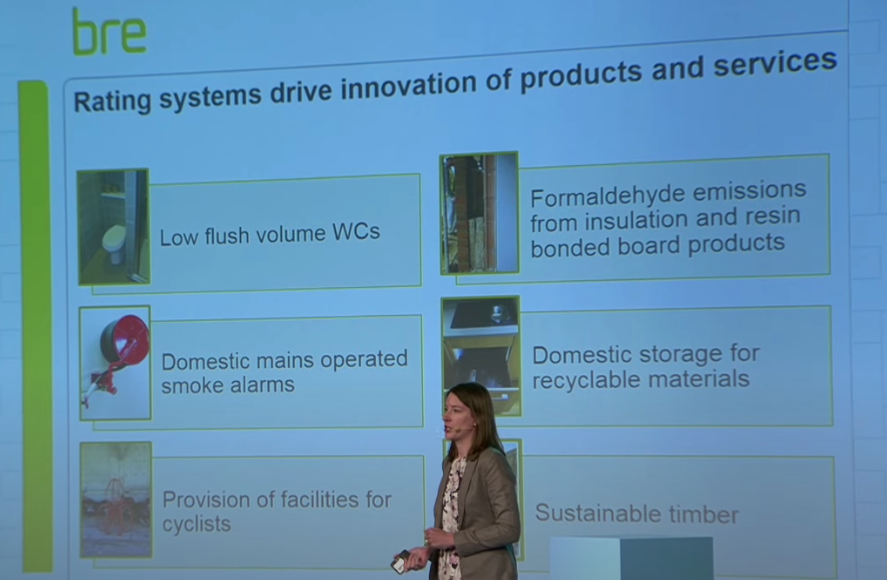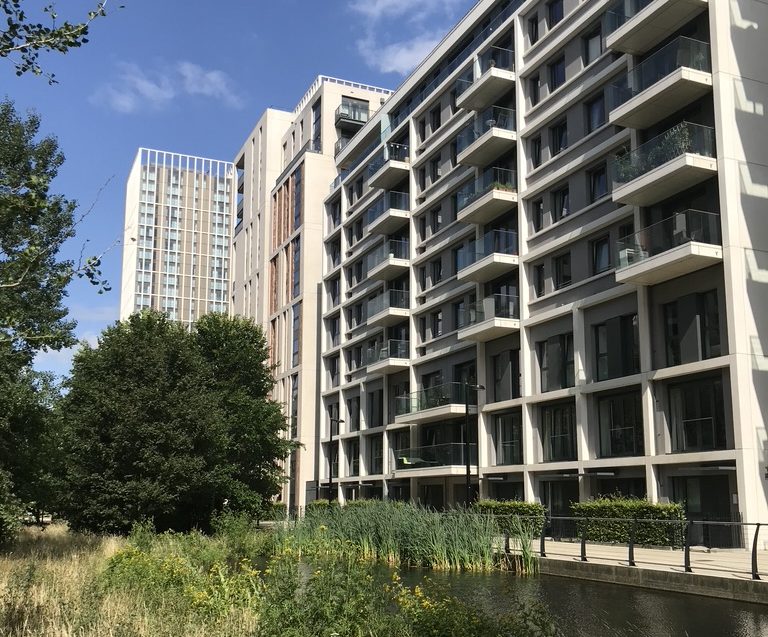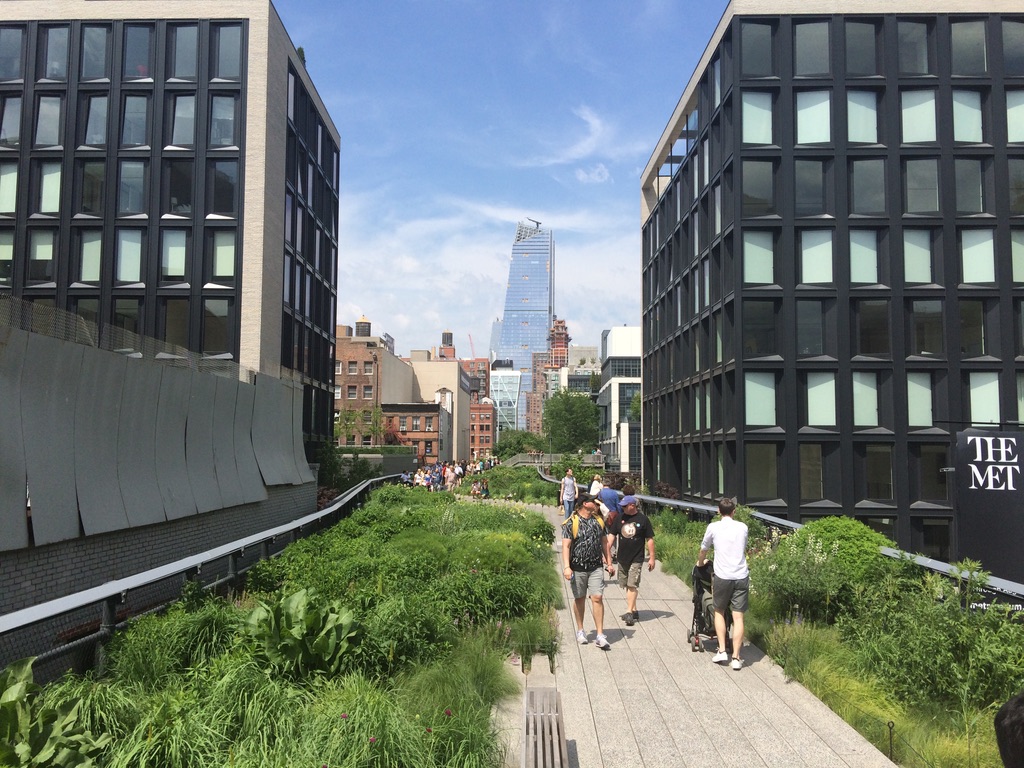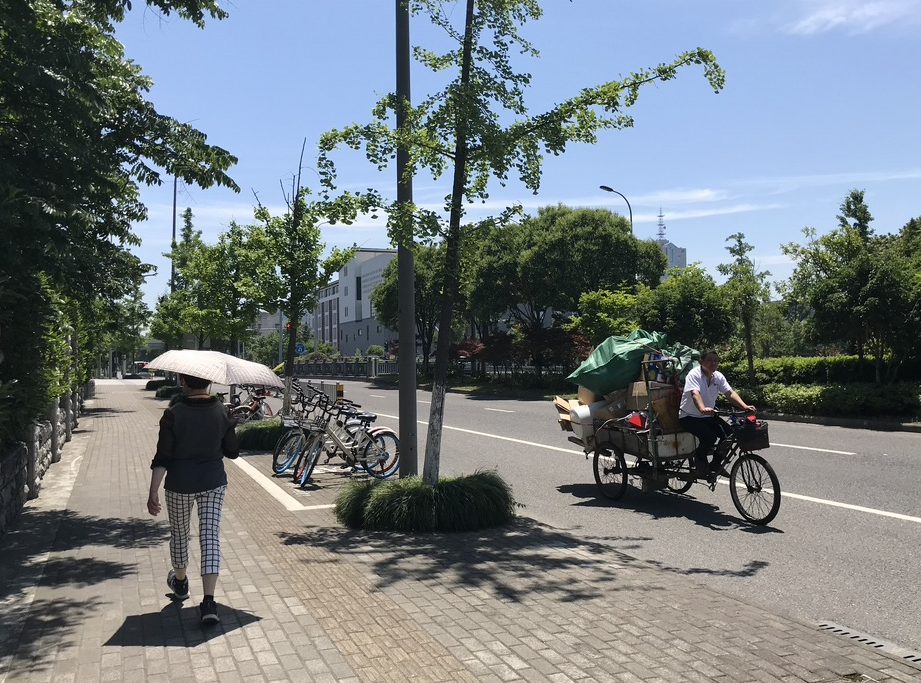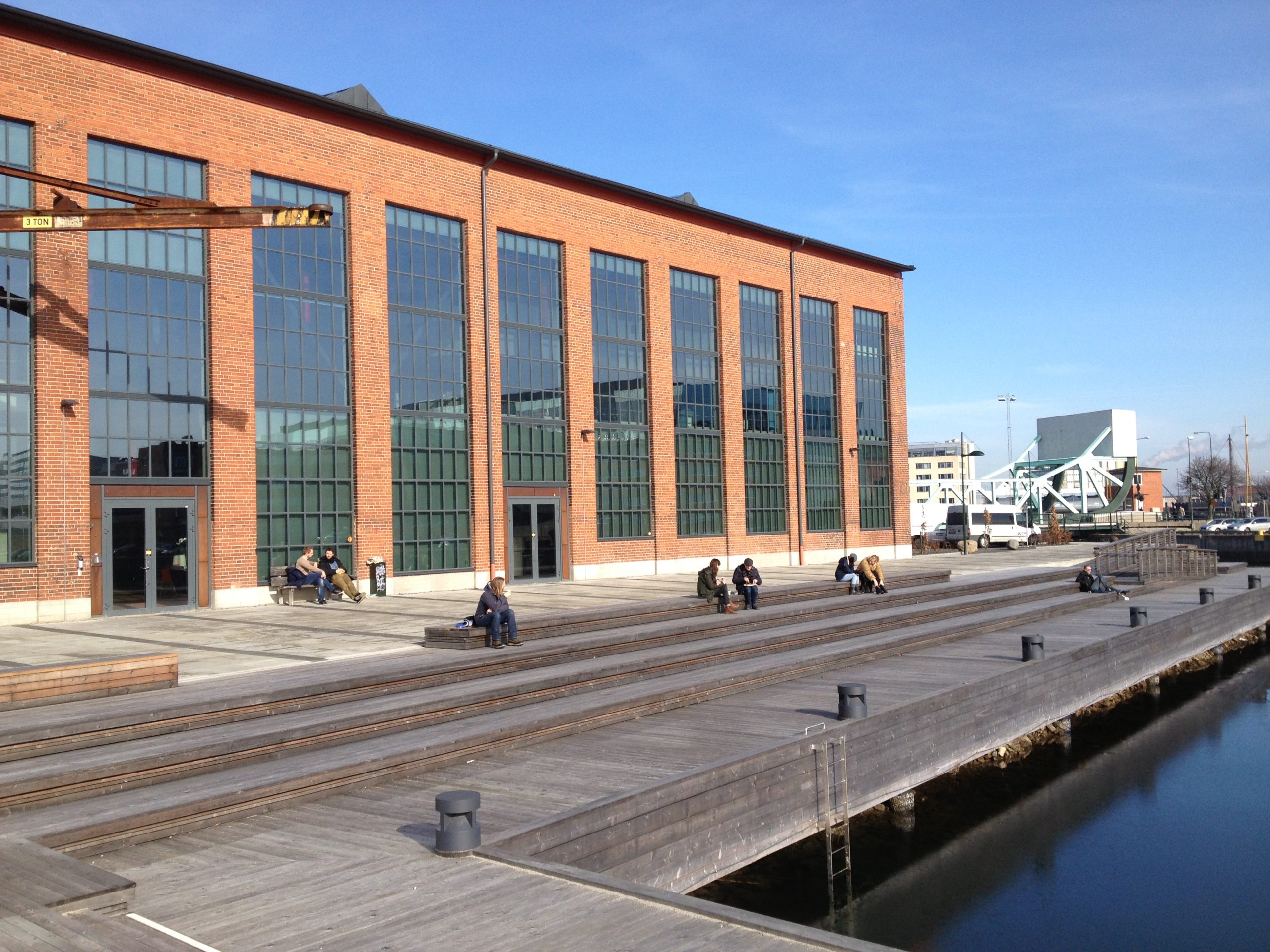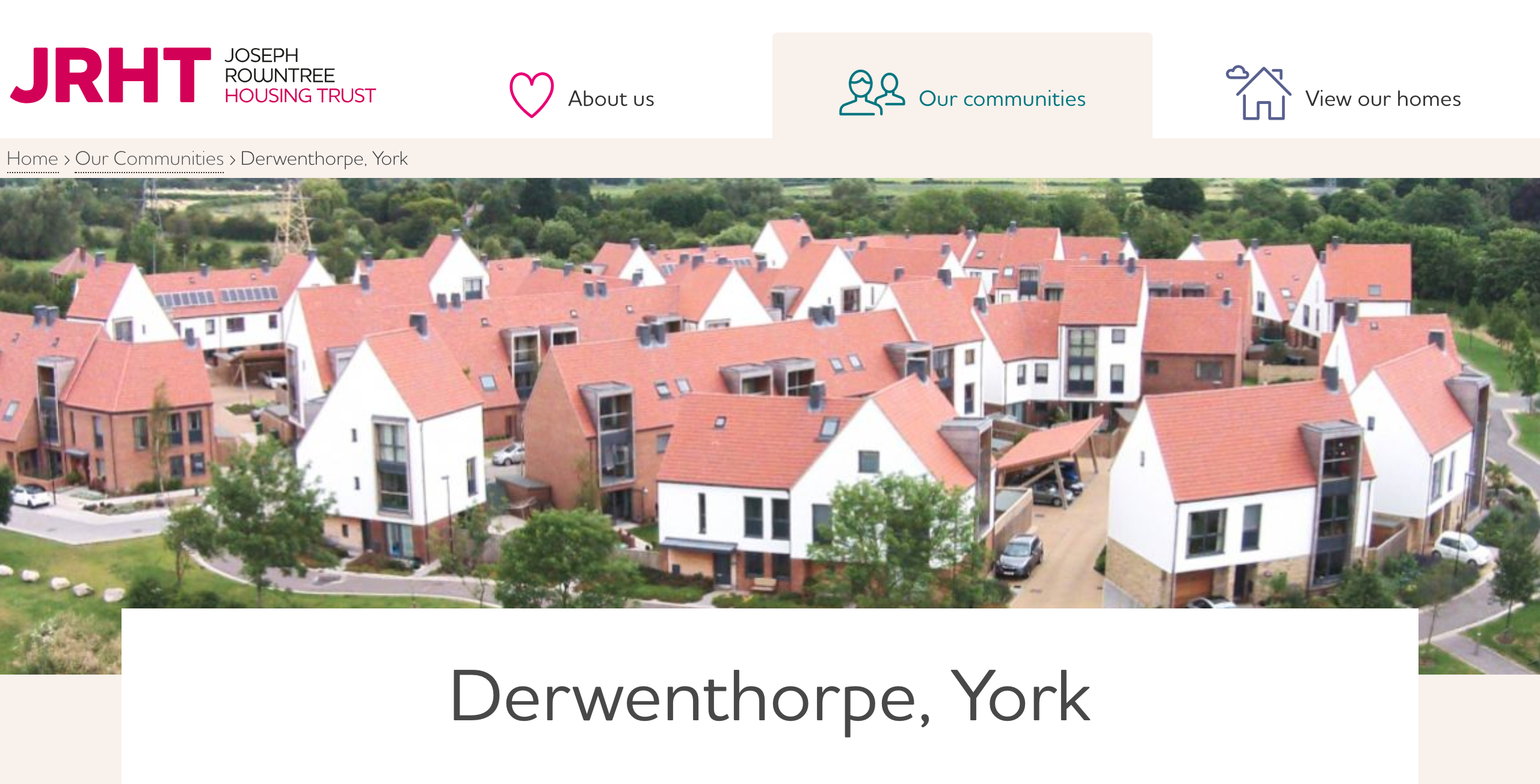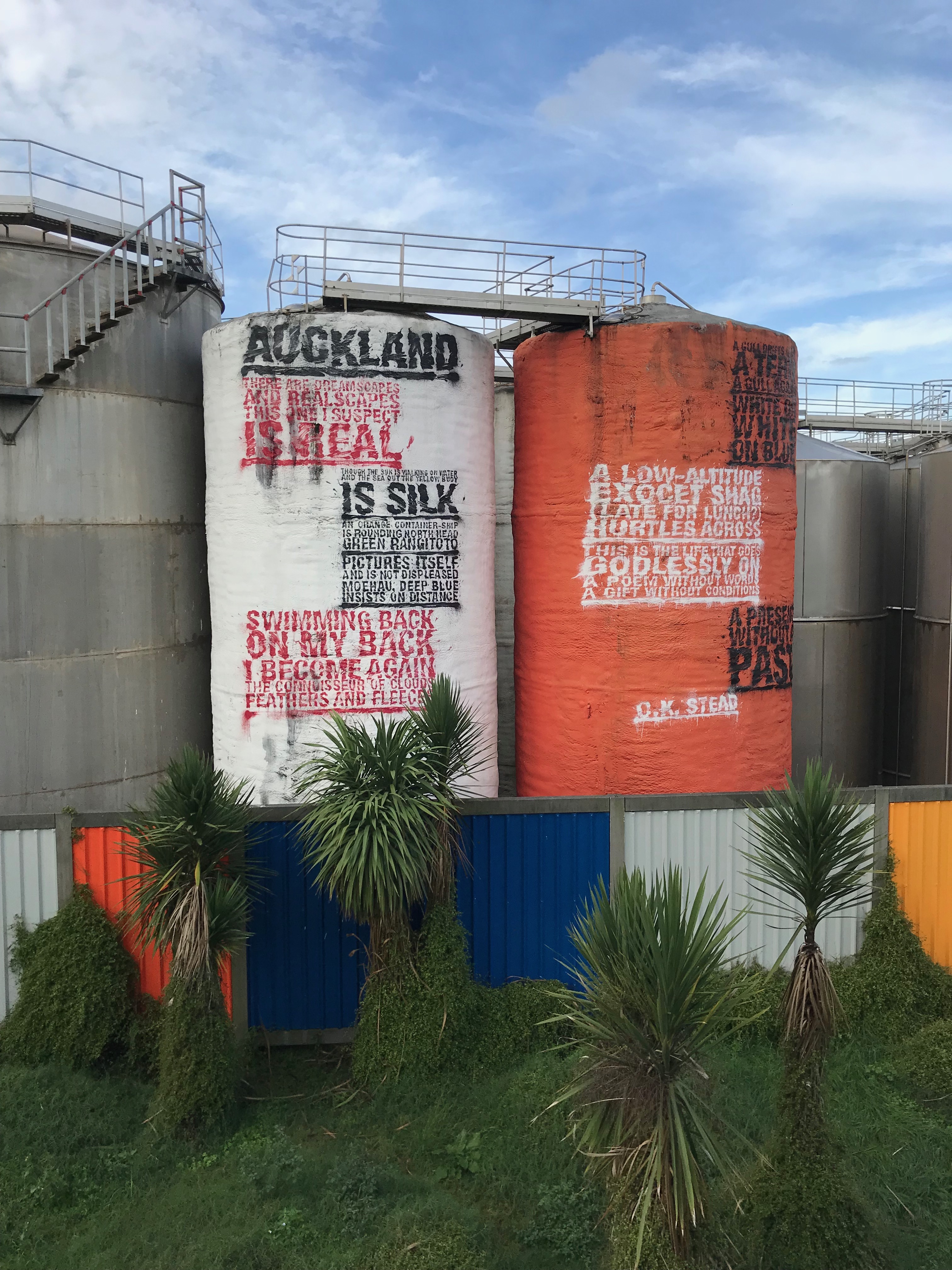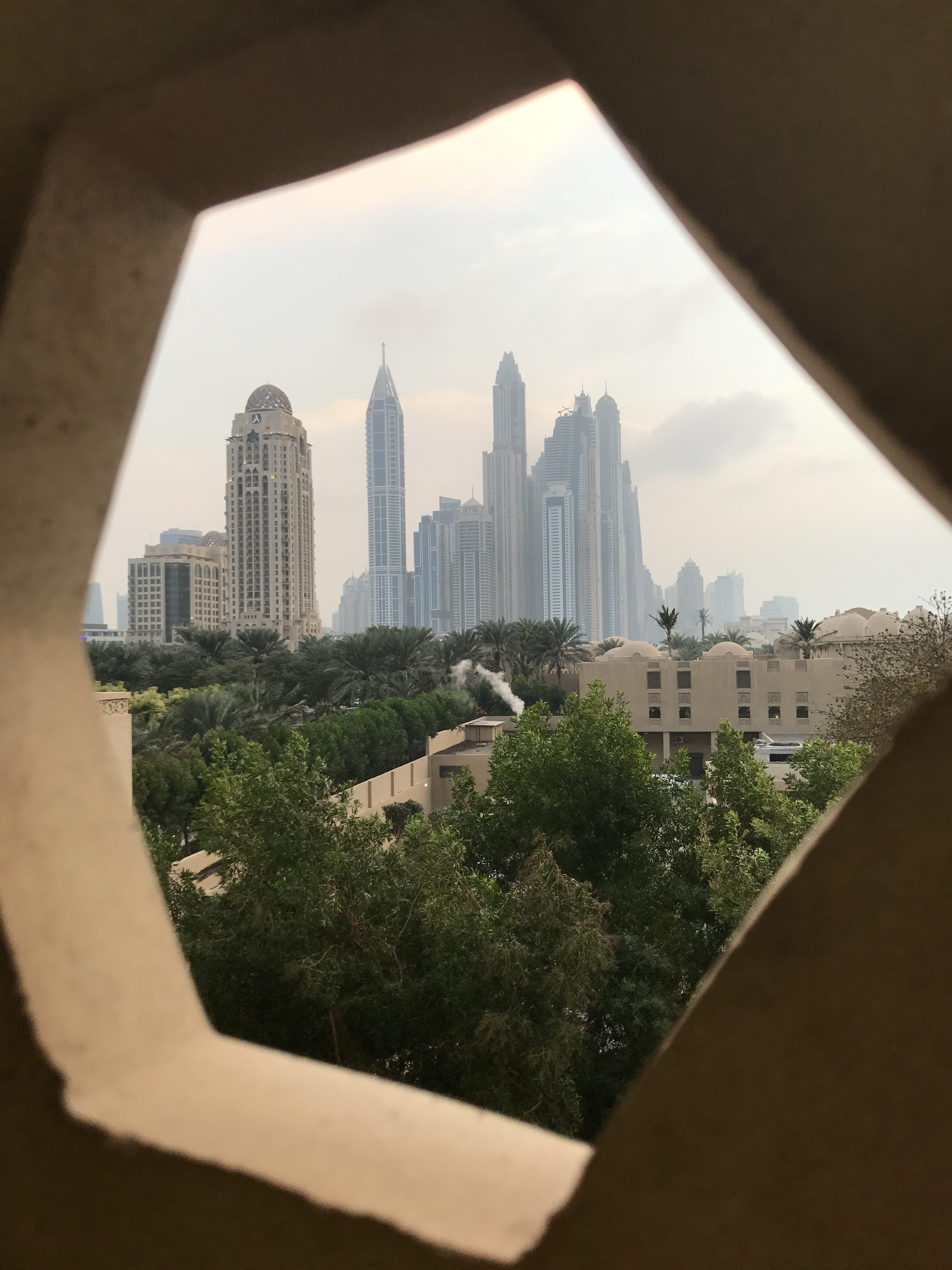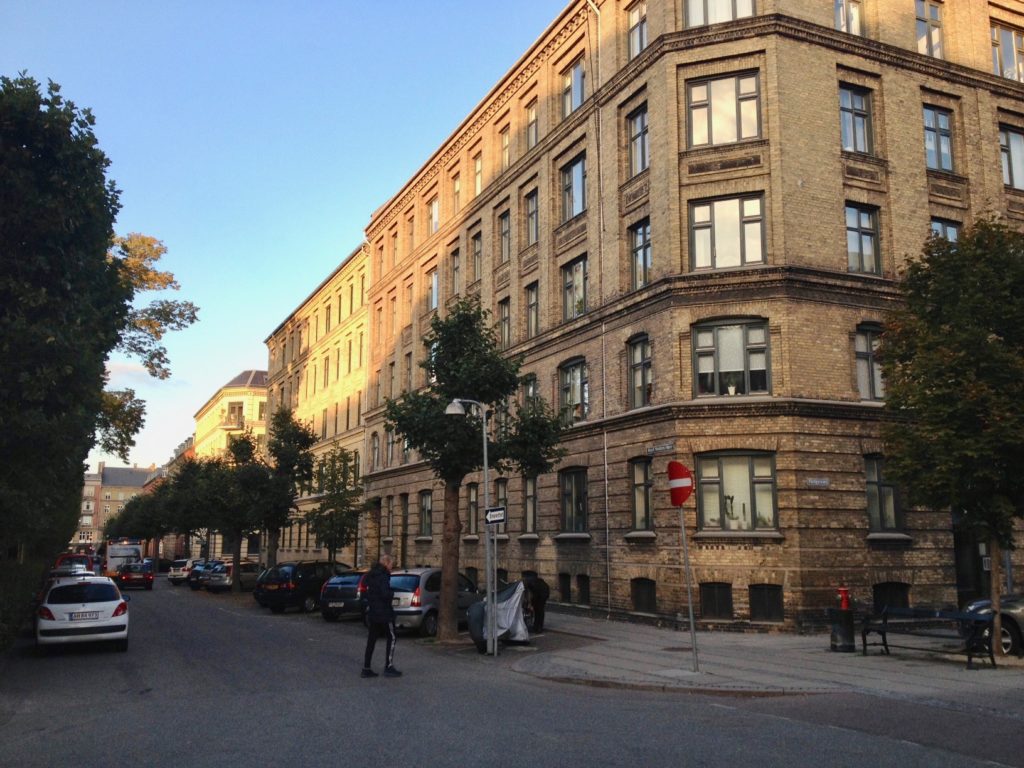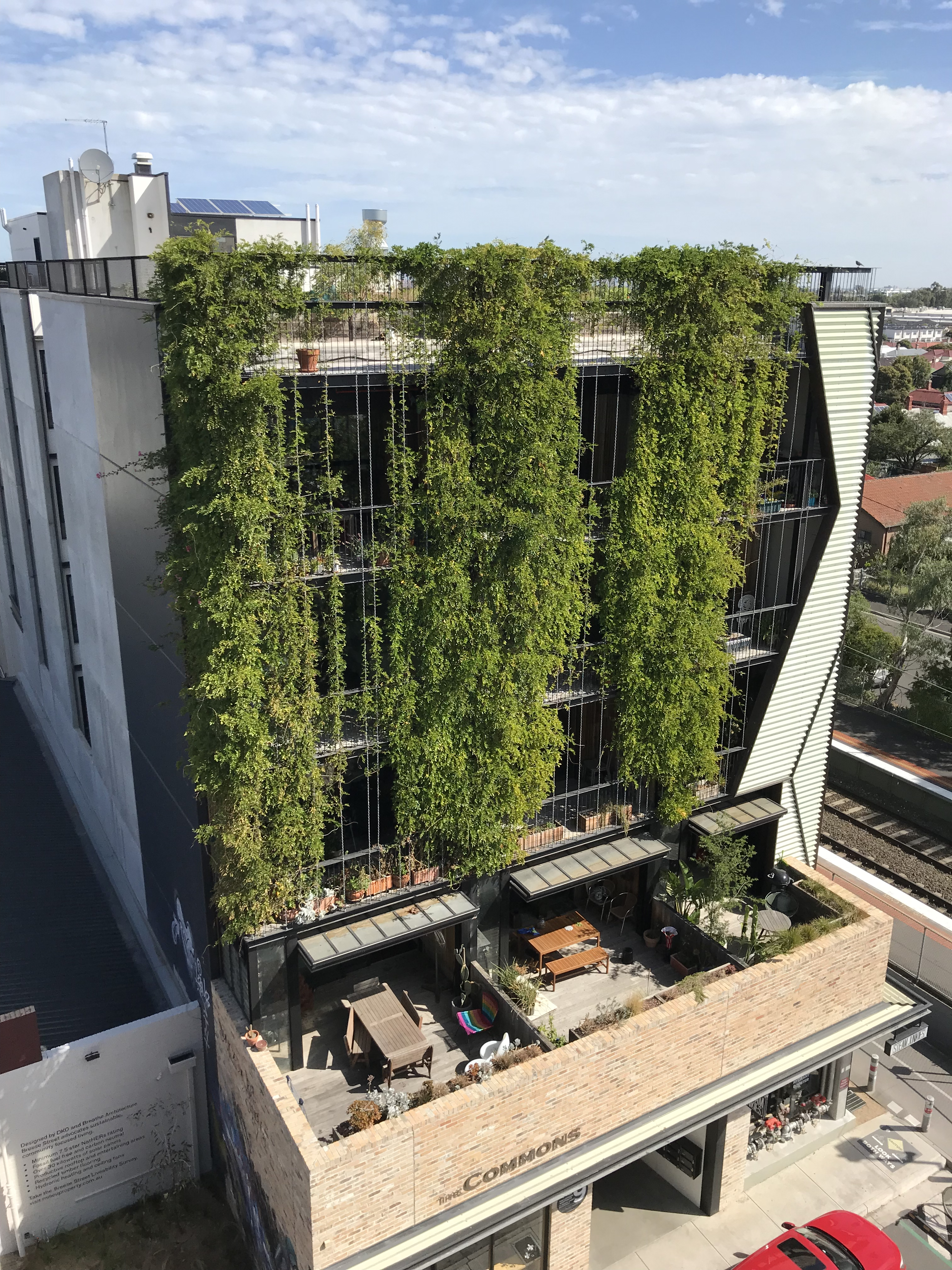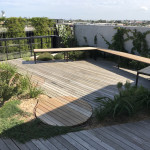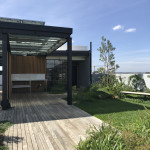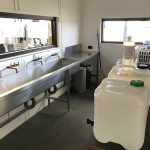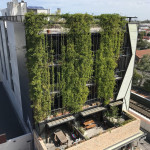I looked into the history of how standards can push innovation in the construction sector when I worked at the BRE. The Building Research Establishment is a not-for-profit organisation in the UK that created the BREEAM standard (BRE Environmental Assessment Method). This video from the Construction Climate Challenge conference in 2015 tells the story of BREEAM standards in particular.
Cities, Health and Well-being
The Royal Institution of Chartered Surveyors commissioned an insight report on ‘Cities, Health and Well-being’. The report explains how urban environments can affect both health and wellbeing in different settings.
Readers will find the following topics:
- An introduction to health in cities, including key urban health trends of increasing chronic diseases and physical inactivity
- An overview of urban environment factors that affect health
- International examples of urban planning policies and new development that have integrated health considerations
- A comparison and overview of building standards that relate to health, particularly the WELL Building Standard and Fitwel
- Discussion of the financial value and cost of achieving healthy places
- A set of top tips for getting started (aimed at built environment professionals).
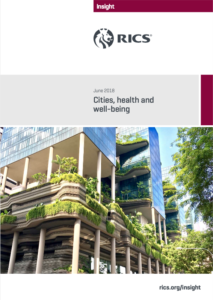
Pineo, H., Rydin, Y., 2018. Cities, health and well-being. Royal Institution of Chartered Surveyors, London.
Healthy planning & regeneration
This report is a summary of best practice related to planning, regeneration, and community engagement about health and place.
The report includes:
- a summary of (evidence-based) health impacts from urban environments (focused on healthy eating, physical activity, social interaction and access to health services);
- a quick reference guide to built environment health impacts and related planning policy responses;
- an overview of the health impacts of regeneration projects;
- examples of innovative ways to involve communities in healthy planning; the role of urban health indicators in monitoring policy impact;
- and further guidance.
This report was the output of a healthy planning project with Southwark and Lambeth Councils in London. The local authority planning and public health departments had several key focus areas that responded to local priorities:
- social isolation
- physical (in)activity
- healthy eating
- integrated health services
The table below shows the built environment topics that were explored in the project, and the strength of evidence for each of the councils’ priority areas.
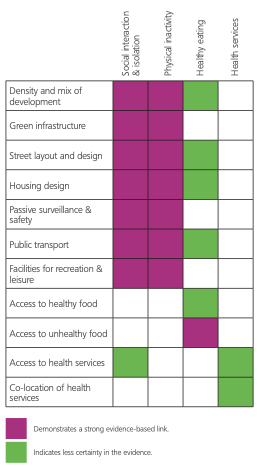
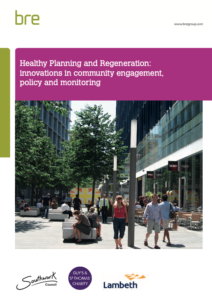
Pineo, H., 2017. Healthy Planning and Regeneration: innovations in community engagement, policy and monitoring. Building Research Establishment (BRE), Watford, UK. doi: 10.13140/RG.2.2.22459.11048
Funding for this report was provided by Guy’s and St Thomas’s Charity and the BRE Trust.
Mobility infrastructure
Transport and mobility infrastructure in cities has many impacts on health and wellbeing, that can be positive or negative. Increasing public transport access to jobs and schools is good for health, while reliance on cars causes pollution and reduced pedestrian safety.
Beyond these local health impacts, transport infrastructure can contribute to climate change and create barriers for wildlife.
Supporting physical activity
There are many health benefits of active transport and mobility infrastructure, including maintaining a healthy weight, reducing risk of chronic disease and improving mental health and wellbeing. Societal also benefits from increasing physical activity through job growth, increased productivity, reduced crime and better social cohesion, to name a few. (1)
The built environment supports physical activity in many ways, through:
- net residential density, intersection density, and public transport density (2);
- proximity (neighbourhood density and mix of uses) and connectivity (ease of movement between destinations) (3);
- sidewalks, street-lighting, and safe crossings (e.g. pedestrian signals and mid-street islands) (3);
- building design
- provision of recreational facilities
- other factors.

Evidence-based design measures
Research shows that the following design and planning measures related to mobility infrastructure can support health:
- Safe active travel routes for all, and especially to schools (4), including dropped curbs at crossings, no obstacles on pavements, safe spaces for pedestrians near vehicle service or drop-off points, etc. (see perceived safety)
- Walking and cycling routes are well-connected and provide direct routes between destinations (5), including design for legibility and wayfinding such as urban form and signage
- Places to rest in public spaces (suitable to different seasons, providing shade and shelter) and access to toilets. (6)
In addition, these built environment measures support physical activity:
- Free or low-cost publicly available facilities/areas that allow opportunities for physical activity (7)
- Indoor and outdoor public recreation facilities (8)
- Active building design through: prominent location and design of stairs, sit-stand and treadmill desks, location of communal areas and toilets in central areas, walking/running tracks and on-site exercise facilities. (6)

Indicators
There are many of urban health indicator tools focused on walkability or wider active transport features. For example, the ‘Physical Activity Neighborhood Environment Scale (PANES)’ tool is a survey that can be used to assess whether existing built environment features support activity. It measures land use mix, residential density, pedestrian infrastructure, aesthetic qualities, and safety from traffic and crime – among other features. (9)
Here are some examples of indicators related to mobility infrastructure, more can be found in the references:
- Walk trip occurrence to work or school (10)
- Sidewalk Quality: % of sidewalks with shade tree coverage (11)
- Transit Service Quality: % of accessible buses for mobility impaired (11)
- Sidewalk Accessibility: % of crossings with curb cuts (11)
- Ratio of bicycle path and lane miles to road miles (12)
For broader indicators for supporting physical activity through the built environment, here are a few examples:
- Reasonable distribution of (environmentally-friendly) public toilets (13)
- % of residents that have access to public exercise facilities in their neighbourhood (14)
- Parks and recreation facilities in the neighbourhood (public or private) are accessible for all residents (7)
- % of people using outdoor space for exercise/health reasons (15)
- Number and quality of children’s play areas accessible to residents (16)
- % respondents satisfied with children’s playgrounds and play areas (17)
Guidance
The Health Economic Assessment Tool (HEAT) for Walking and Cycling was developed by the World Health Organization to measure the economic value of health benefits achieved from reduced mortality from walking and cycling. (18)
A research collaboration between Arup, BRE, University College London and AREA Research (Perkins+Will) aimed to help decision-makers deliver better mobility infrastructure in their cities through an improved understanding of the impact of mobility/infrastructure on wellbeing.
The resulting design protocol explained the links between physical and mental health to the availability of active and non-active transport modes for daily journeys.
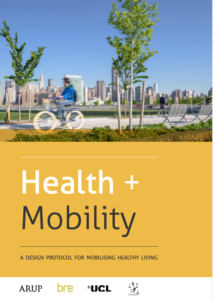
References
(1) Designed to Move, Active Cities: A Guide for City Leaders. 2015; published online June. http://www.designedtomove.org/resources/active-cities.
(2) Sallis JF, Cerin E, Conway TL, et al. Physical activity in relation to urban environments in 14 cities worldwide: a cross-sectional study. The Lancet 2016; 387: 2207–17.
(3) Saelens BE, Sallis JF, Frank LD. Environmental correlates of walking and cycling: Findings from the transportation, urban design, and planning literatures. Ann Behav Med 2016; 25: 80–91.
(4) Younger M, Morrow-Almeida HR, Vindigni SM, Dannenberg AL. The Built Environment, Climate Change, and Health. Am J Prev Med 2008; 35: 517–26.
(5) Panter J, Guell C, Humphreys D, Ogilvie D. Title: Can changing the physical environment promote walking and cycling? A systematic review of what works and how. Health Place 2019; 58: 102161.
(6) Pineo H, Rydin Y. Cities, health and well-being. London: Royal Institution of Chartered Surveyors, 2018 http://www.rics.org/uk/knowledge/research/insights/cities-health-and-well-being/ (accessed June 19, 2018).
(7) Kim S, Adamson KC, Balfanz DR, et al. Development of the Community Healthy Living Index: A tool to foster healthy environments for the prevention of obesity and chronic disease. Prev Med 2010; 50, Supplement: S80–5.
(8) Bethlehem JR, Mackenbach JD, Ben-Rebah M, et al. The SPOTLIGHT virtual audit tool: a valid and reliable tool to assess obesogenic characteristics of the built environment. Int J Health Geogr 2014; 13. DOI:http://dx.doi.org.libproxy.ucl.ac.uk/10.1186/1476-072X-13-52.
(9) Sallis, J.F., Kerr, J., Carlson, J.A., Norman, G.J., Saelens, B.E., Durant, N., Ainsworth, B.E., 2010. Evaluating a brief self-report measure of neighborhood environments for physical activity research and surveillance: Physical Activity Neighborhood Environment Scale (PANES). Journal of physical activity and health 7, 533–540.
(10) Ulmer JM, Chapman JE, Kershaw SE, Campbell M, Frank LD. Application of an evidence-based tool to evaluate health impacts of changes to the built environment. Can J Public Health 2015; 106: ES26–32.
(11) Peterborough County-City Health Unit; GreenUP; City of Peterborough. Active transport and health: indicators report. 2014. Available from: http://www.peterborough.ca/Assets/City+Assets/TDM/Documents/indicators+report.pdf. Accessed 20 Nov 2015.
(12) About the SF Indicator Project. The San Francisco Indicators Project. http://www.sfindicatorproject.org/about. Accessed 29 Mar 2016.
(13) Gu C, Dongping Y. The Environmental Risks Of Rapid Urbanization: Indicators For Livable Cities. In: Chinese Research Perspectives On The Environment, Vol 1: Urban Challenges, Public Participation, And Natural Disasters. PA LEIDEN: BRILL, 2013: 159–73.
(14) Colorado Health and Environmental Data, Colorado Department of Public Health. Colorado Health Indicators. http://www.chd.dphe.state.co.us/HealthIndicators/home/index (accessed Feb 11, 2016).
(15) Public Health England. Public Health Profiles, Wider Determinants of Health, Built and Natural Environment. https://fingertips.phe.org.uk/profile/wider-determinants/supporting-information/built-and-natural-environment (accessed Aug 4, 2019).
(16) Weich S, Burton E, Blanchard M, Prince M, Sproston K, Erens B. Measuring the built environment: validity of a site survey instrument for use in urban settings. Health Place 2001; 7: 283–92.
(17) Bristol City Council. The quality of life in Bristol. bristol.gov.uk. https://www.bristol.gov.uk/statistics-census-information/the-quality-of-life-in-bristol (accessed Oct 30, 2016).
(18) Kahlmeier S, World Health Organization, Regional Office for Europe. Health economic assessment tools (HEAT) for walking and for cycling: methodology and user guide : economic assessment of transport infrastructure and policies. 2011.
A sustainability standard in Malmö
When I worked at the UK’s Building Research Establishment I spent some time managing the sustainable masterplanning standard called BREEAM Communities. We travelled to Malmö, Sweden to apply the 2012 version of the standard on the large scale urban regeneration taking place on the Western Harbour.
This video, filmed by BRE, shows how public and private sector stakeholders perceived the value of BREEAM Communities in 2012.
Top 10 Tips for Healthy New Communities
There’s a lot of guidance about designing healthy communities from public health and built environment professionals. For a change, I found it interesting to hear what Lord Richard Best called his ‘Top 10 Tips’ for designing healthy communities. Lord Best is ‘not a fan of major UK housebuilders’ because he feels their level of quality is not up to muster. So his example healthy development, Derwenthorpe, is led by the Joseph Rowntree Housing Trust, not a private developer.
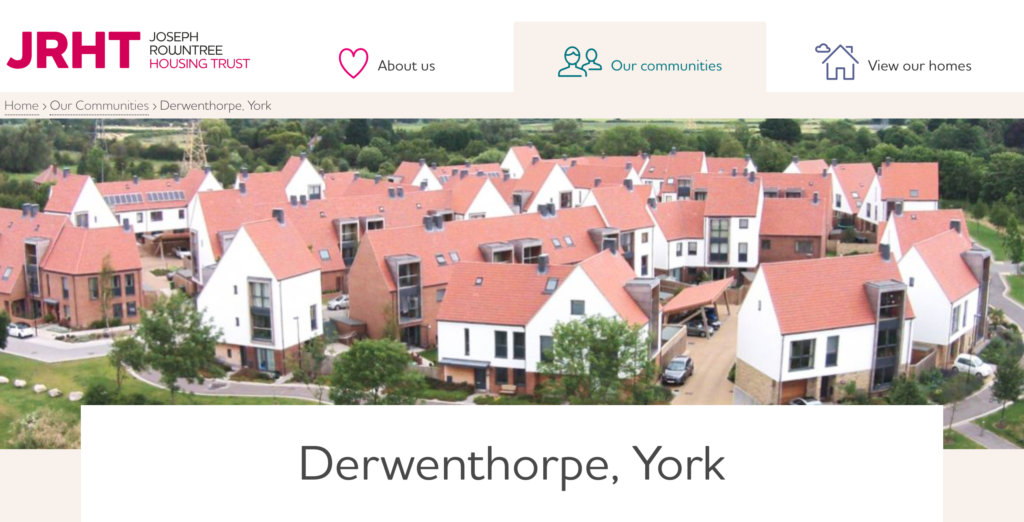
Lord Best has an informed position on designing and planning healthy communities based on his roles as Vice President of the Local Government Association and the Town & Country Planning Association, and co-chair of the All-Party Parliamentary Group on Housing and Care for Older People. He was also the CEO of the Joseph Rowntree Foundation (1988-2006).
Derwenthorpe is a new development of 489 ‘attractive, affordable, eco-friendly family homes in a digitally inclusive, mixed-tenure community’.1 It’s situated on the edge of an existing village, Osbaldwick, outside of York. Here’s what Lord Richard Best thinks makes this development healthy – couched as his ‘Top 10 Tips’:
Top 10 tips for healthy places (not in any order):
- Affordable housing – 40% are rented on secure tenancies
- Lifetime Homes Specification (fully accessible – good for all ages and conditions)
- Walkable for children – safe footpaths to school
- A ‘Sustrans’ accessible barrier-free track to the centre of York
- Residents get a free bus pass for a year or a loan to buy a bicycle
- Home zones (shared street space) where pedestrians have the right of way
- Substantial play spaces for children
- Sustainable Drainage Systems to avoid flooding (and water ingress into homes)
- Electric vehicle charging points on each home, one car parking spot per house and a car club
- Affordable heating and power – they have a Combined Heating and Power (CHP) system providing low cost energy for residents.
There are more details on the Joseph Rowntree website (below) with other features of this development that contribute to its sustainability and health credentials.
1Derwenthorpe on the Joseph Rowntree Housing Trust website: https://www.jrht.org.uk/community/derwenthorpe-york
Auckland’s Wynyard Quarter renewal project
Given the long timespans of urban regeneration projects – spanning decades from initial plans to completion – I happened upon New Zealand’s largest renewal project at just the right time. Wynyard Quarter is well along its transformational journey from an industrial port into a very liveable and sustainable community.
In April 2018 it was already clear that Auckland’s planners have used fantastic public realm design and amenities to turn the port into a welcoming, walkable and fun neighbourhood. Having visited or worked on some of the world’s leading portside developments in Sweden, Hammarby, BO01 and Masthusen, I can see that this project will likely become a case study in sustainable design and development.
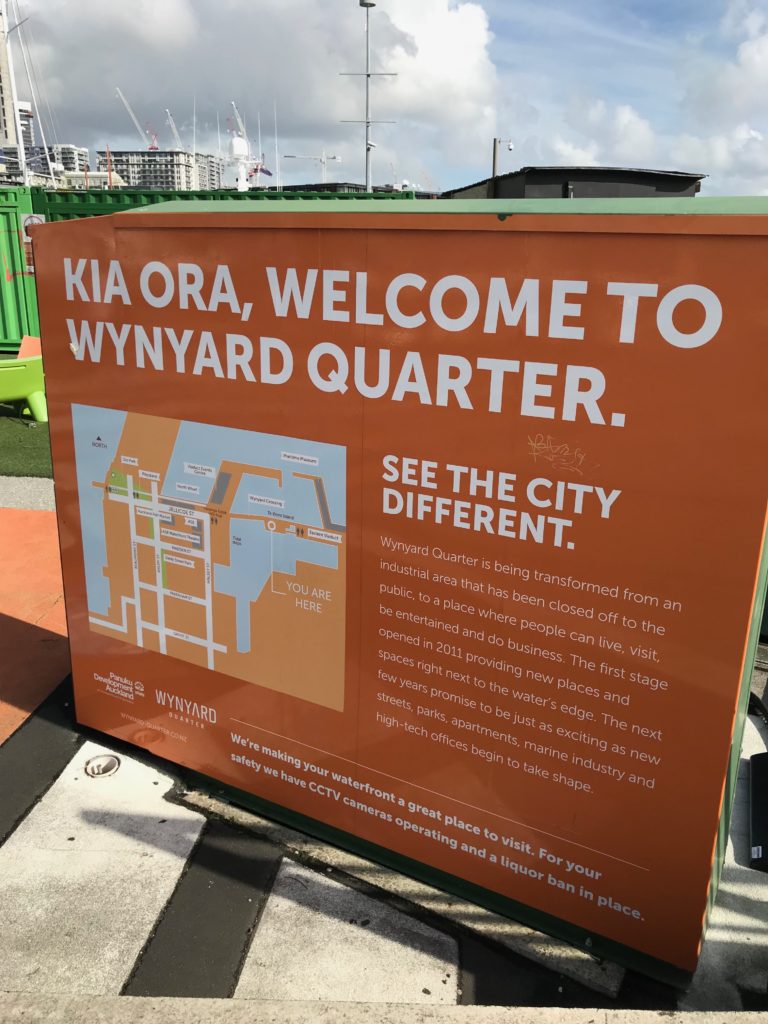
Walking from Auckland’s CBD you’re drawn west, past the ferry terminal and under the New Zealand’s Team America’s Cup Yacht at the Maritime Museum. You enter Wynyard Quarter by passing rows of luxury yachts and crossing a pedestrian drawbridge. As you approach, there are meanwhile uses, pocket parks and information boards drawing attention to the redevelopment. There will be 500 homes and 48,000 sq meters of commercial space in the central area of the quarter, much of which is starting to take shape now.
Visiting with my young family, we walked straight past the lovely waterside bars and restaurants to Silo Park. There is something here for all ages. A water feature, basketball net, and ‘under the sea’ themed playground were being enjoyed by children, teenagers and adults. Posters advertised outdoor concerts and an open-air cinema project against one of the silos. My favourite part was walking up the gantry, a bridge-like structure with multiple levels and partly covered in plants. It offered fantastic views of the emerging neighbourhood and the harbour bridge beyond.
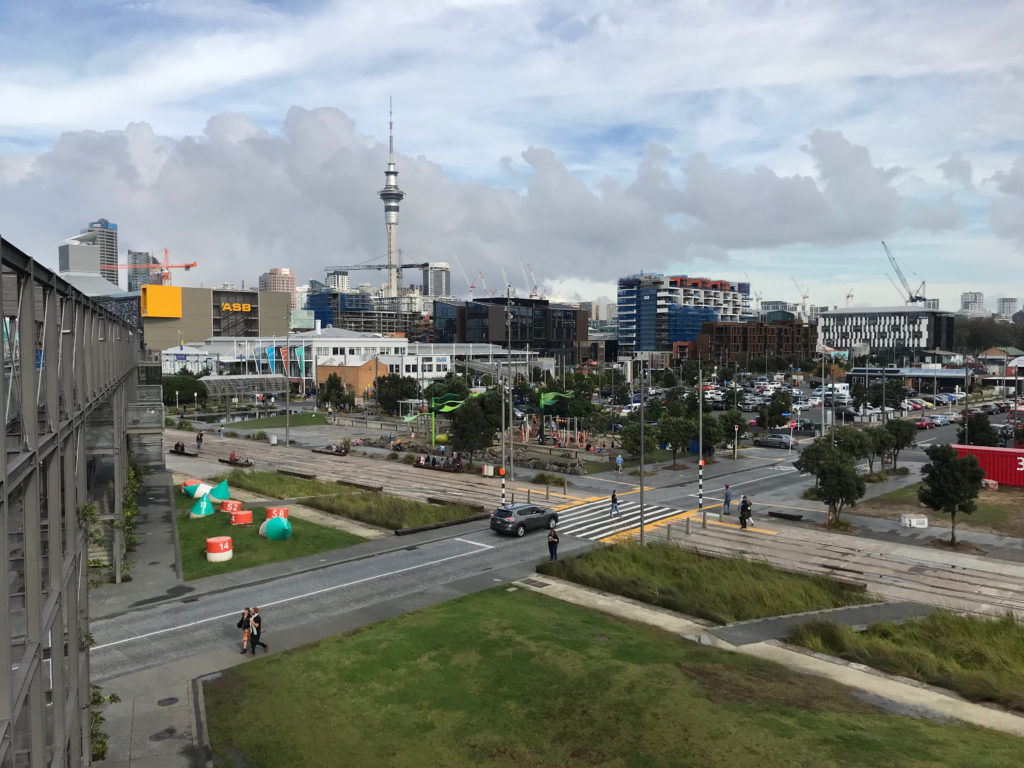
There are many planning frameworks setting out the ambitions and development requirements for Wynyard Quarter on the Panaku Development Auckland website. The project’s Sustainable Development Framework aims to move beyond zero net energy, water and waste impacts to a built environment that positively contributes energy and water and is ‘restorative’. Among other requirements, homes have a minimum target of 7 Homestar rating1 while commercial buildings will need to reach 5 Green Star rating2.
The city wants Wynyard Quarter to be a place where residents are proud of their contribution to a ‘more sustainable future’. This project has the most sophisticated monitoring system that I’ve ever seen for a masterplanning project to showcase its progress against sustainability goals, called Wynyard Quarter Smart.
Users of this online interactive tool can view information on a map of the neighbourhood or through navigating different theme areas, such as ‘Transport, Movement & Connectivity’. It’s fantastic to see that the project managers are reporting their progress throughout the renewal project.
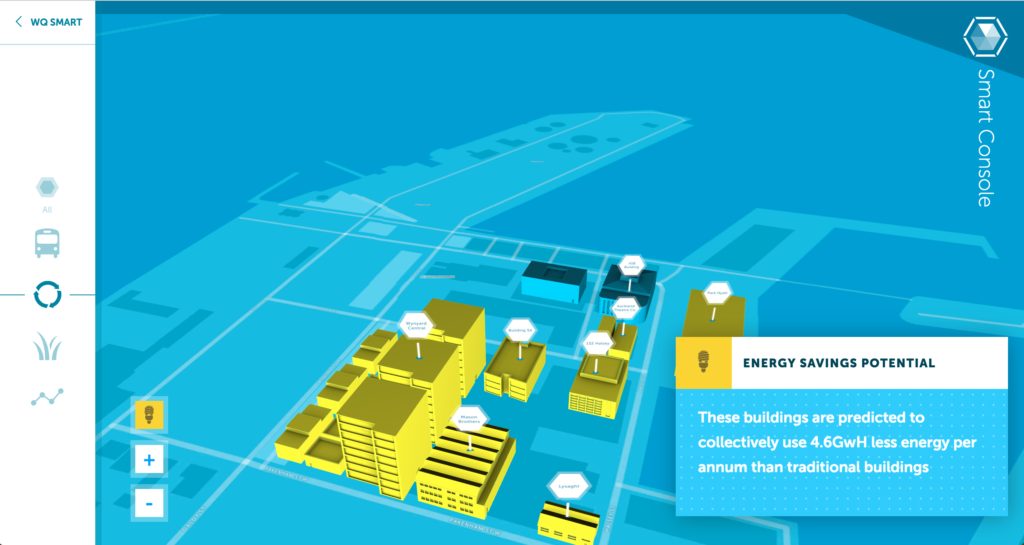
This regeneration project is leading practice in many areas, incorporating smart systems and adopting ambitious goals for sustainability and health. Just reporting what I saw on my brief visit, here are some of the outstanding design and planning features that will support the developments’ goals for generations to come:
- Infrastructure first: The housing development is just beginning but even early residents will be able to adopt healthy and sustainable behaviours such as walking or cycling because the street infrastructure is already in place to support this. There are also plenty of things to do in the area so that people will have reasons to interact and develop a sense of community.
- Public realm design for all ages: People of all ages and abilities will find the parks and amenities around Silo Park to be fun and accessible. The gantry structure has a lift and stairs so wheelchair users or parents with buggies can see the outstanding views from the top deck.
- Safe streets: The crossing points are clearly marked and level. The pavements are wide and allow plenty of space for pedestrians and cyclists.
- Sustainable drainage: The sustainable drainage systems contribute to the landscape aesthetic and filters water.
- Identity – marine and industrial heritage: This place has a very strong sense of identity that comes across through the design of the public realm – buoys floating in grass, the gantry, the ‘under the sea’ playground, the remnants of train tracks, and of course the silos.
Wynyard Quarter is a great place to visit, live or work. If you’re planning a similar project in your city, it would be well worth exploring their approach to sustainability and the incorporation of health and social wellbeing principles. It has already won an ‘Excellence on the Waterfront’ award in the Comprehensive Plans category in the USA.
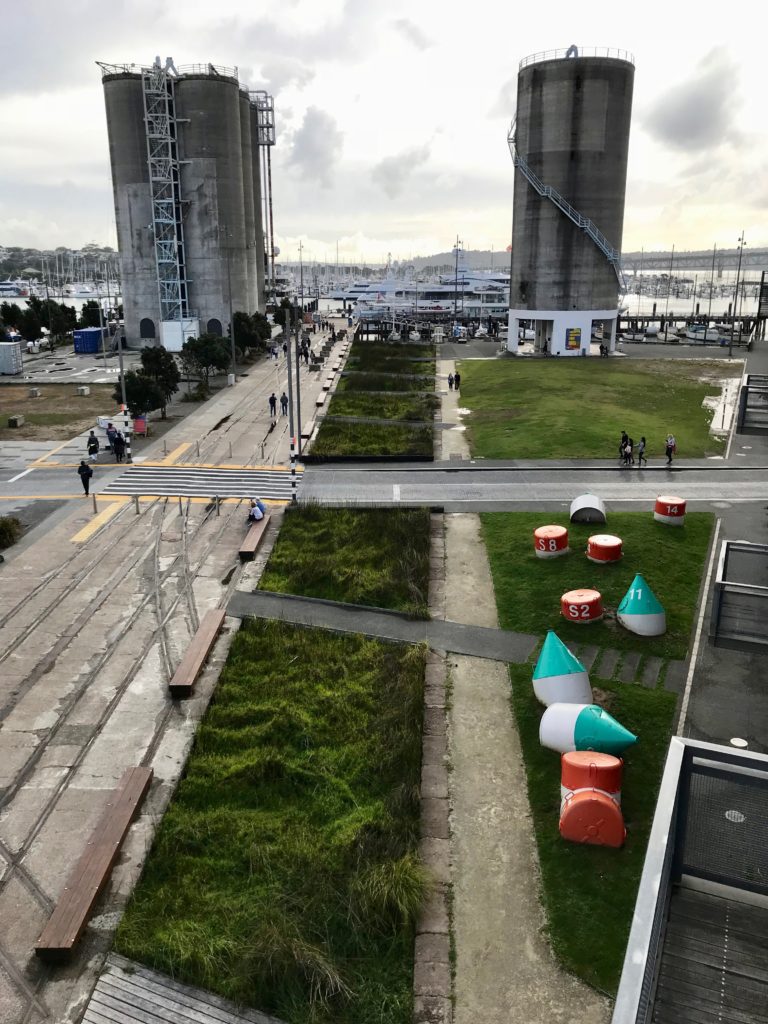
- New Zealand Green Building Council’s standard for sustainable healthy homes, https://www.nzgbc.org.nz/homestar
- Green Building Council Australia’s standard for sustainable buildings, https://new.gbca.org.au/green-star/
Are tall buildings always a bad form of housing?
Cities around the world use tall buildings to accommodate high density development in well-serviced areas. Yet the list of potential negative impacts of tall buildings seems to outweigh the benefits. As the Grenfell Tower tragedy so horrifically demonstrated, if tall buildings are poorly designed or managed they can have catastrophic impacts on residents. Many urbanists argue that even high quality well-maintained tall buildings are bad for residents’ wellbeing. Given the need to accommodate so much urban growth in a sustainable, equitable and affordable way, can we consider tall buildings as a viable housing solution?
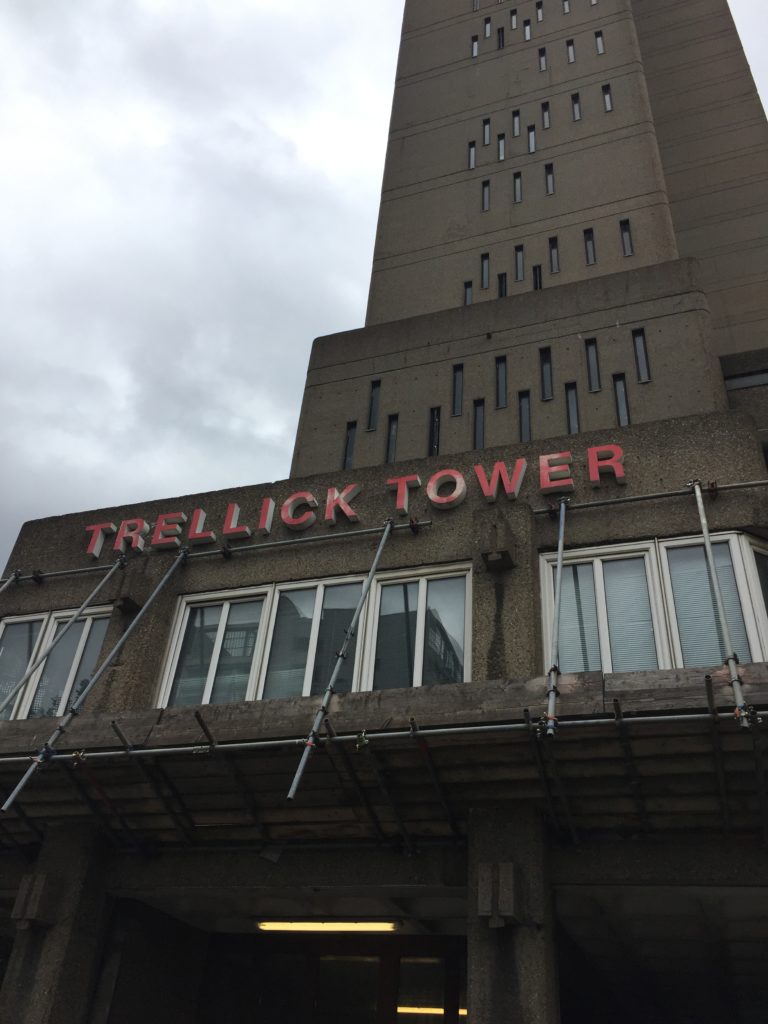
Swiss-born architect Le Corbusier proposed the use of tall buildings as a means of lifting the urban poor out of overcrowded squalid slums in early 20th century Europe. His designs extended to sixty stories for offices and seventeen for dwellings and were surrounded by park land.1 These vertical cities were intended to include ample recreational facilities (including on rooftops) with attention to noise pollution, sunlight and thermal control, among other health-related design measures. Alexi Marmot argued that many British and American 1950s and 1960s high-rise housing estates inspired by Le Corbusier failed to implement features he deemed essential such as the provision of social and sport facilities, management services and regular community policing.1 These buildings therefore failed to realise Le Corbusier’s vision and many have since been demolished.
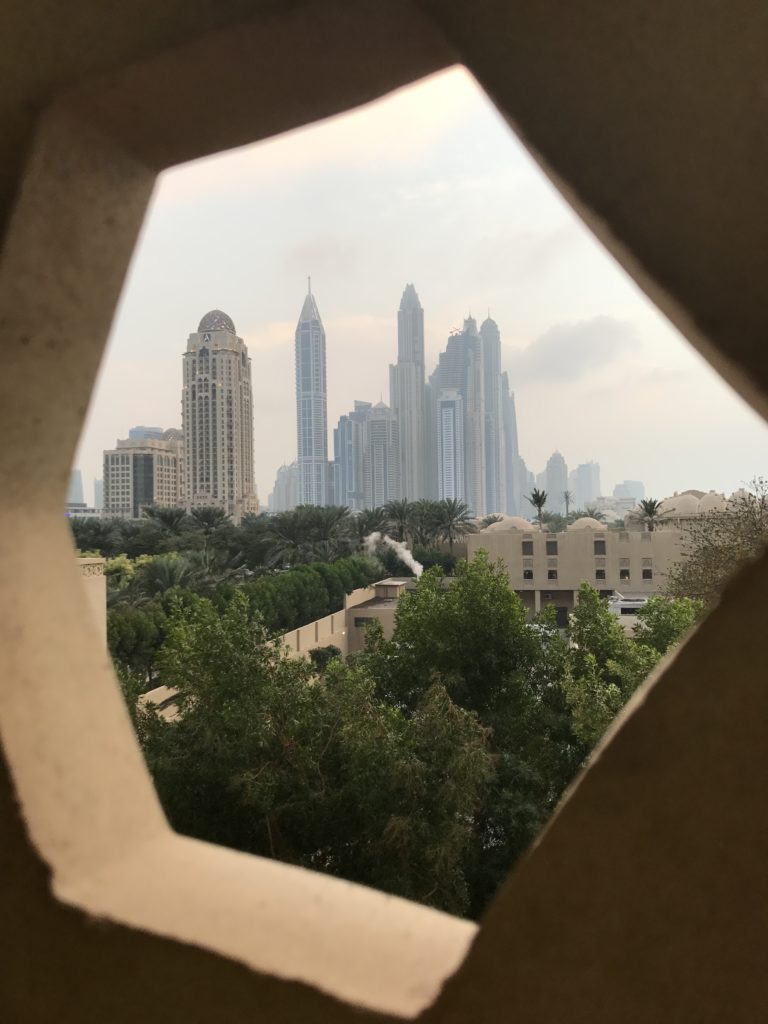
The Draft London Plan says that ‘tall buildings can form part of a strategic approach to meeting regeneration and economic development goals, particularly in order to make optimal use of the capacity of sites which are well-connected by public transport and have good access to services and amenities’.2 It also references other positive benefits of high buildings including: they act as navigation aids in the city and they contribute to the London skyline and the city’s identity. Although one could ask the cut-off point for the latter two benefits, as examples like Dubai show that after a while another tall building doesn’t stand out that much.
The list of potential negative impacts of tall buildings in the Draft London Plan is quite long:
- visual impacts at multiple scales (including on heritage assets)
- microclimate effects (wind, canyon effects) and impact on air pollution particle movement
- reflective glare (see infamous example of walkie-talkie building burning car)
- interference with aviation, telecommunication, etc.
- impact on neighbouring buildings’ sunlight, temperature, wind, etc.
- noise pollution
- effect on local infrastructure requirements.
The Create Streets charity has been lobbying for the avoidance of multi-storey residential development in London since 2013. They argue that very few people choose to live in tall buildings (with notable exceptions like the Barbican). Counterintuitively, they also claim that you can fit the same number of people in dense townhouse development using the same land area.3 Their list of detrimental impacts of tall buildings includes:
- usually disliked by residents
- correlated with bad outcomes for residents
- bad for society and crime levels
- poor return on investment over the long-term
- more expensive to build and maintain
- bad for children and families.3
Many tall buildings around the world are luxury developments with high-end design and amenities for residents. So is the wellbeing of residents an issue of design and execution or would residents of all tall buildings experience negative results? As with anything related to urban development, equity becomes a key issue. In London, tall buildings are used as a way to make urban infill development economically viable. Taller buildings have more housing units bringing returns to the developer, and those units with a view can bring in a premium. We as planners are told that the overall viability of a site depends on the additional storeys added to tall buildings. Allowing these storeys may increase the number of affordable homes that can be constructed on the site alongside other amenities such as playgrounds.
As usual, there are a number of issues for planners to balance and there are no categorically right or wrong answers. High density is good for walkability and environmental sustainability, but it is very unclear whether tall buildings are the right form to achieve these aims. Some of the negative impacts outlined above can be mitigated through design and engineering measures. For my personal living preference, Le Corbusier’s limit of seventeen stories for residential buildings still seems quite tall. There may be a natural height limit that humans find manageable. I would prefer the 5-6 storey apartment blocks of Copenhagen to the towers of Tokyo, but perhaps we can adapt to what we can afford.
References
- Marmot AF. The Legacy of Le Corbusier and High-Rise Housing. Built Environment; London. 1981;7(2):82–95.
- Mayor of London. Policy D8 Tall buildings. Draft New London Plan. https://www.london.gov.uk/what-we-do/planning/london-plan/new-london-plan/draft-new-london-plan/chapter-3-design/policy-d8-tall-buildings. Published November 14, 2017. Accessed April 26, 2018.
- Boys Smith N, Morton A. Create streets: Not just multi-storey estates. Policy Exchange and Create Streets. 2013.
Cool living in a hot climate
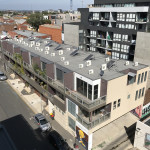
Melbourne isn’t the hottest of Australian cities, with summer temperatures around 26°C (79°F). Yet there can be wide swings between hot and cool weather in a single day and periodic heat waves have peaked at 47°C (117°F). Most homes and buildings operate air conditioning units and even on my visit here in March this added cooling is welcome. But mechanical systems are energy intensive, noisy, costly and they add heat to the external environment, contributing to the urban heat island effect.
Architects in Melbourne working on the Nightingale Housing model have come up with some fantastic designs for natural cooling and ventilation, alongside a whole range of other sustainability features. The Nightingale 1 building, designed by Breathe Architecture, is in the Brunswick neighbourhood of Melbourne a few minutes from Anstey rail station. My host, planner Rod Duncan, arranged for us to meet one of the architects and current residents, Dan McKenna, who kindly showed us around. On the ground floor the building has a shared entrance for Nightingale Housing offices and residents to the 20 flats. Across the street is The Commons apartment building (same architects) and a gallery for another architecture firm. There’s also a pop-up park, coffee bar, cafe, natural wine & craft beer shop across the ground floors of these two buildings. Although the rest of the area is largely light industry warehouses, the shops and ubiquitous street art are adding to the growing sense of community.
Updated on 10 April 2018 to correct information on Melbourne’s climate (kindly provided by Rod Duncan).
Healthy place-making doesn’t have to cost extra
There is a common view amongst developers that designing and building for health and wellbeing objectives is more expensive than standard projects and that it doesn’t offer return on investment. I have recently written an article which summarises evidence from a range of organisations, including the Royal Institution of Chartered Surveyors and the Urban Land Institute, to counter these claims.
The built environment can provide access to physical activity at a range of scales, from transport and mobility infrastructure to provision of parks and even through building design. This is one of the most important features to consider given the cost of not getting this right. Public Health England reported that physical inactivity directly contributes to 1 in 6 deaths in the UK and costs £7.4 billion a year to business and wider society.(1) Through active design measures, a new masterplanned community of 5,700 homes in Texas has boosted physical activity of residents by 40-50 minutes a week.(2) BRE’s recent Design Protocol for Health + Mobility (in partnership with Arup, UCL and AREA Research) provides further information on integrating physical activity into masterplanning and transport infrastructure.(3)
The design of healthy homes and buildings has received significant attention from the development sector. Evidence from a Saint-Gobain commissioned survey demonstrated that 30% of the households surveyed would be willing to pay more for homes which do not compromise health.(4) By considering health impacts at the early stages of design, designers and developers can use integrated design solutions which do not cost extra and allow all homes to be safe and supportive of health and wellbeing. Healthy design should not just become a feature of high-value developments but should be delivered on all schemes. Developers using the Home Quality Mark and BREEAM will find that health and wellbeing is fully integrated into these standards and supports integrated design measures.(5)
The full article is published in the Town and Country Planning Association’s special edition journal entitled ‘#healthyplanning – Securing Outcomes from United Action’, available to download here.
This post was originally posted on BRE Buzz and is cross-posted here.
References
- Petrokofsky C, Davis A. Working Together to Promote Active Travel: A briefing for local authorities. Public Health England; 2016.
- Kramer A, Lassar TJ, Federman M, Hammerschmidt S. Building for Wellness: The Business Case. Washington DC: Urban Land Institute; 2014.
- Health + Mobility: A Design Protocol for Mobilising Healthy Living. Arup, BRE, UCL, AREA Research; 2016.
- UK Green Building Council. Health and Wellbeing in Homes. UKGBC; 2016. Available from:
- Taylor T, Pineo H. Health and wellbeing in BREEAM. BRE Global Ltd.; 2015.

